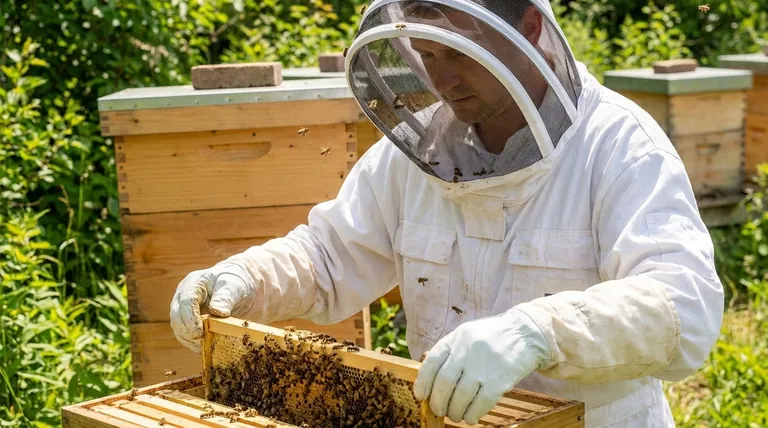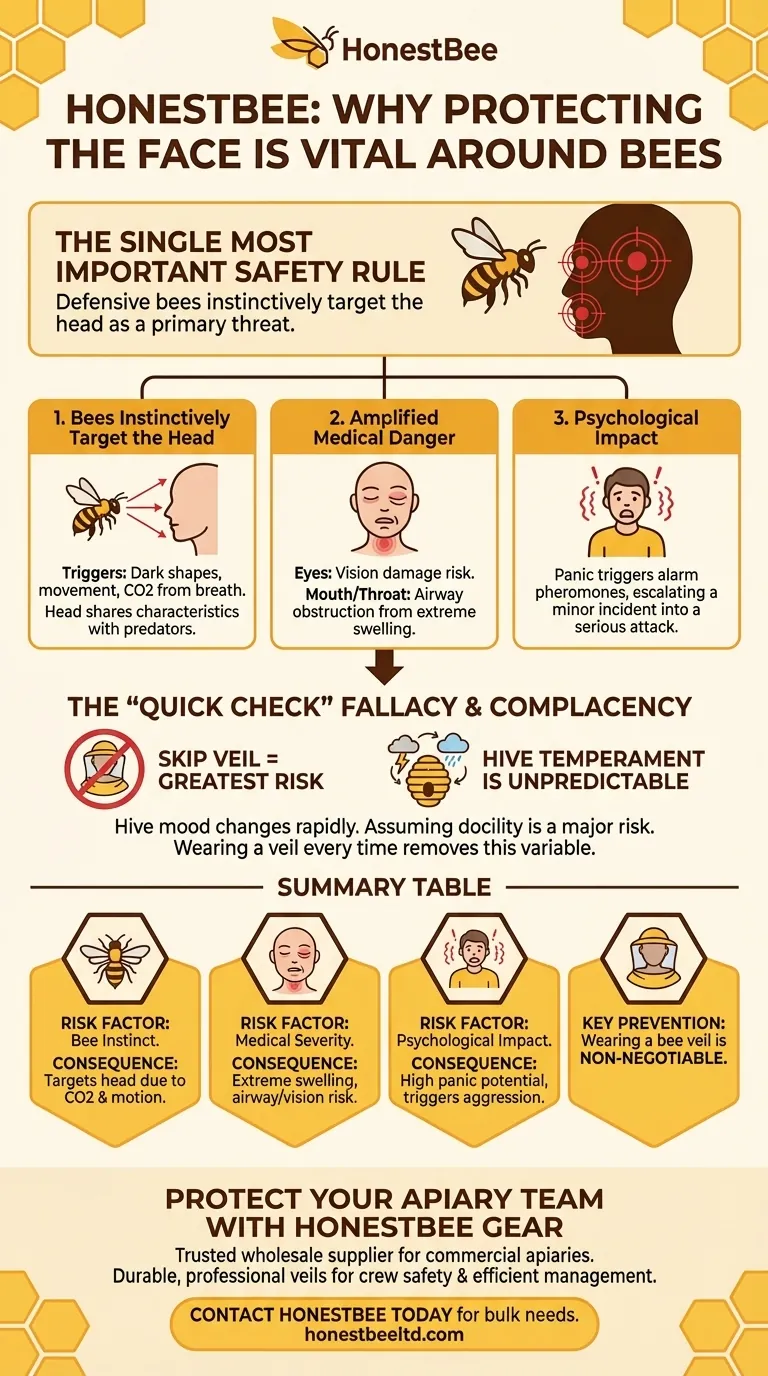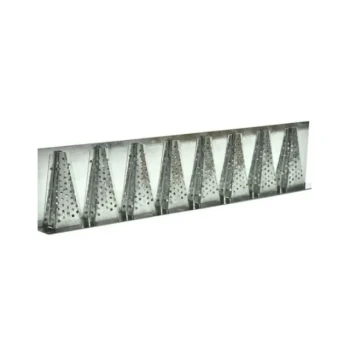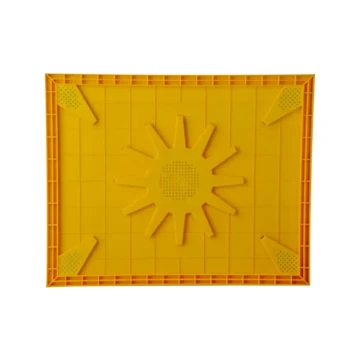Protecting your face is the single most important safety rule when working with honey bees. Defensive bees instinctively target the head area as the primary threat to their colony. Because of this behavior, a sting to the face—especially the eyes, mouth, or nose—is not only more likely but carries significantly greater medical risk than a sting elsewhere on the body.
While a sting is painful anywhere, a sting to the face represents a unique and elevated risk. It is a predictable outcome of bee defense strategy, and protecting against it is the foundational principle of safe beekeeping, mitigating dangers that range from severe pain to serious medical emergencies.

The Core Reasons for Prioritizing Facial Protection
To work confidently around bees, you must understand their defensive behavior. The need for a veil is not about fear; it's about respecting the bee's biology and mitigating predictable risks.
Bees Instinctively Target the Head
Honey bees have evolved for millions of years to defend their hive from large predators like bears and badgers. Your head and face share key characteristics with these threats.
Defensive guard bees are triggered by dark, moving shapes and the carbon dioxide you exhale. Your face, mouth, and eyes are a perfect combination of these triggers, making them a natural target.
The Amplified Danger of Facial Stings
A sting on the hand is painful, but a sting on the face can be a medical issue. The soft tissues around your eyes, lips, and nose are highly sensitive and prone to extreme swelling.
A sting near the eye can cause temporary or even permanent vision damage. A sting inside the mouth or throat is particularly dangerous, as the resulting swelling can lead to a critical airway obstruction.
The Psychological Impact
A sting to the face is far more startling and likely to induce panic than a sting to an arm or leg. Sudden, panicked movements are perceived as an aggressive act by the bees.
This reaction can trigger a chain reaction, where one sting releases alarm pheromones that incite other bees to attack, escalating a minor incident into a serious one. A calm demeanor, maintained by the confidence a veil provides, is your best defense.
Understanding the Trade-offs
Even experienced beekeepers can become complacent, leading to unnecessary risks. Understanding the most common mistake is crucial for developing safe habits.
The Fallacy of the "Quick Check"
Many incidents occur when a beekeeper decides to skip the veil for what they believe will be a "quick" task, like refilling a feeder or a brief visual inspection.
This thinking is flawed because a hive's temperament is not static. It can change rapidly due to weather, time of day, a recent disturbance, or the stage of the nectar flow.
Why Complacency Is the Real Threat
A hive that was calm yesterday may be highly defensive today. Assuming a hive will always be docile is the single greatest risk a beekeeper can take.
Wearing a veil for every interaction, no matter how brief, removes this variable. It ensures your safety is not dependent on the unpredictable mood of the colony.
Making the Right Choice for Your Goal
Your level of interaction dictates the necessary protection, but awareness of your face is always paramount.
- If your primary focus is active beekeeping (e.g., hive inspections): Always wear a veil, without exception. This is a non-negotiable tool for preventing serious injury and maintaining the calm control needed to work effectively.
- If your primary focus is simply working near a known hive (e.g., gardening): While a full veil is not required, remain aware that your head is a target. Avoid swatting at bees near your face and move slowly and calmly if they investigate you.
Ultimately, protecting your face is not a sign of fear; it is the mark of a knowledgeable and responsible individual working in harmony with these essential creatures.
Summary Table:
| Risk Factor | Consequence of a Facial Sting |
|---|---|
| Bee's Instinct | Targets head due to CO2, movement, and dark shapes. |
| Medical Severity | Extreme swelling near eyes/mouth; risk of airway obstruction or vision damage. |
| Psychological Impact | High potential for panic, triggering a more aggressive, widespread bee response. |
| Key Prevention | Wearing a bee veil is non-negotiable for any hive interaction. |
Protect your apiary team with the right safety gear from HONESTBEE.
As a trusted wholesale supplier for commercial apiaries and beekeeping equipment distributors, we provide durable, reliable veils and protective equipment designed for professional use. Ensure your crew's safety and maintain calm, efficient hive management.
Contact HONESTBEE today to discuss your bulk beekeeping supply needs and keep your operation safe and productive.
Visual Guide

Related Products
- Beekeeping Gloves Goatskin Leather with Long Cotton Sleeve for Beekeepers
- Mesh Ventilated 3 Layer Goatskin Beekeepers Gloves for Beekeeping
- Professional Galvanized Hive Strap with Secure Locking Buckle for Beekeeping
- Plastic Handle Single Row Artificial Fiber Bee Brush
- High Performance Plastic Queen Excluder for Beekeeping and Apiary Management
People Also Ask
- What are the features of ventilated bee gloves? Stay Cool & Dexterous in Warm Weather
- What are the advantages of goatskin leather gloves for beekeeping? Superior Sting Protection for Your Apiary
- What are the arguments for and against using gloves in beekeeping? Balancing Protection and Dexterity
- What is the difference between cleaning cow leather and goat leather beekeeping gloves? Tailor Your Care for Longevity
- Why do some experienced beekeepers choose not to wear gloves? For Superior Dexterity & Hive Welfare



















